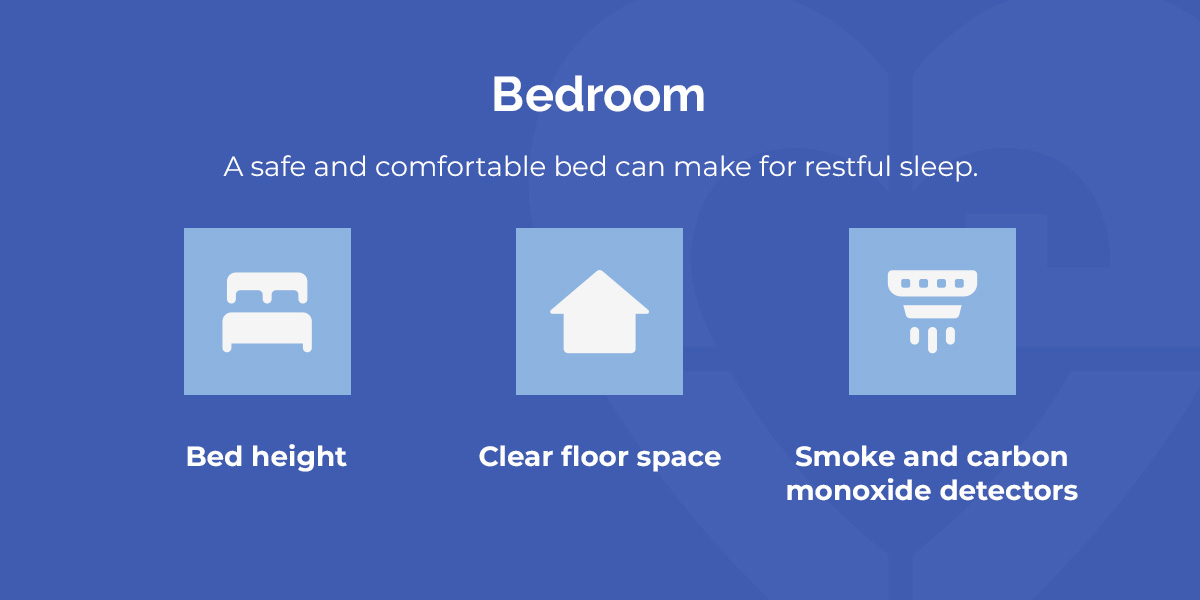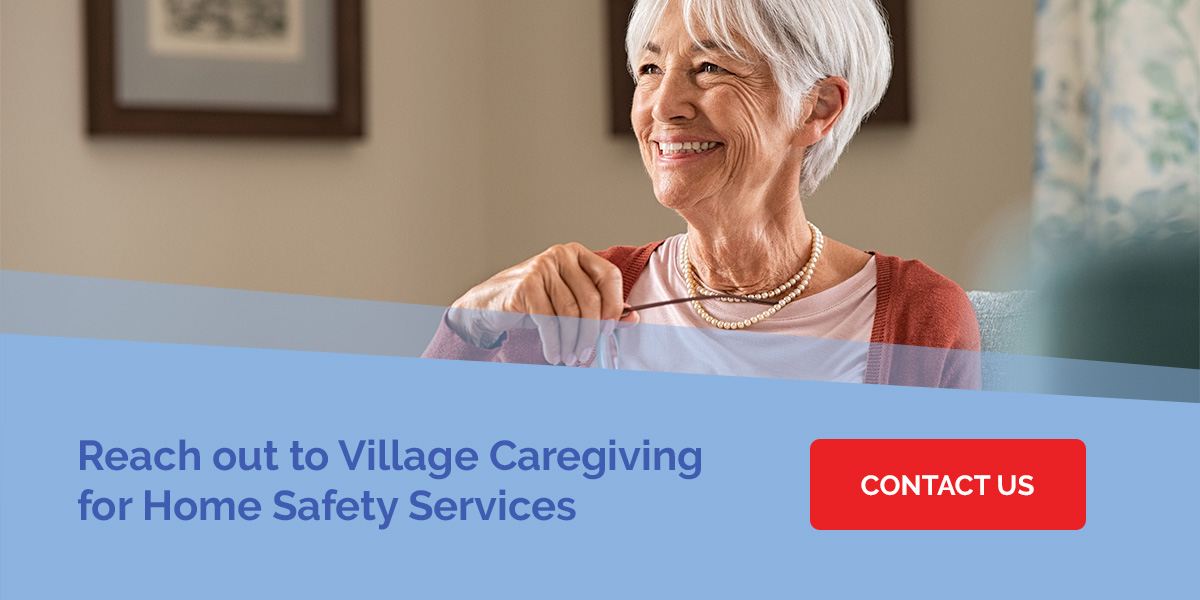As we age, creating a safe and secure home becomes a necessity. Each room in the house can have potential hazards, but making some adjustments can prevent falls and other accidents and help you or a loved one live comfortably.
Understanding the Safety Needs of Older Adults
Aging brings about physical, cognitive and sensory changes that can increase the risk of accidents in the home.
- Physical: As people age, they often experience a decline in strength, balance and coordination. These changes can make it more challenging to perform everyday tasks like climbing stairs, getting in and out of chairs or reaching for items on high shelves. Joint stiffness and muscle weakness can also increase the risk of falls, which are one of the leading causes of injuries among older adults.
- Cognitive: Memory loss, confusion and reduced problem-solving abilities can make it difficult for older adults to move around freely. Those with dementia or Alzheimer’s may struggle to recognize hazards or remember how to use household appliances properly.
- Sensory: Many older adults experience changes in their vision, hearing and sensitivity to temperature. Reduced vision can make it difficult to see obstacles, while hearing loss may prevent them from hearing alarms or doorbells. Diminished sensitivity to heat or cold can increase the risk of burn or hypothermia.
General Home Safety Measures for Older Adults
Certain safety measures are beneficial in multiple areas of the home and form the foundation of a secure living environment.
Lighting
Every room, hallway and entryway should be well-lit to prevent accidents. Use bright, energy-efficient LED lights to make moving around the home safe. Installing task-specific adjustable lamps that can be directed to provide focused light in the kitchen, living room, bedroom, and bathroom can also be handy.
Nonslip Mats
Place nonslip mats in areas prone to moisture, like the bathrooms, kitchen and entryways. These mats should have a strong grip to prevent them from sliding out of place. If possible, install nonslip flooring materials, like textured tiles, vinyl or rubber to provide additional traction. It’s also best practice to secure loose rugs with nonslip backing or remove them altogether to prevent tripping hazards.
Windows
Windows do more than just let in light. With the right adjustments and features, they can add an extra layer of safety.
Proper insulation helps maintain a comfortable temperature inside the home, which can be helpful for older adults who may be more sensitive to temperature changes. Insulated windows keep the house warm in winter and cool in summer, creating a more stable and comfortable environment. Securing windows with strong locks can deter unauthorized entry and give loved ones a greater sense of security.
Emergency Notification Systems
Having a reliable way to call for help during an emergency is a fantastic feature for older adults living alone. Install buzzers in the bathroom, kitchen, living room and bedroom to quickly alert caregivers or family members if assistance is needed. Consider investing in a medical alert device that connects to a 24/7 monitoring center. Medical alerts can be worn as necklaces, bracelets or keychains and include a button to call for help.
Interior Home safety
Once you’ve completed the basics, you can focus on specific improvements for each area of the home.
Bathroom
The bathroom is one of the most hazardous rooms in the home because of slippery surfaces and the need for frequent use. Some safety considerations include:
- Grab bars and handrails: Installing grab bars near the toilet, shower and bathtub provides extra support and stability. Handrails should be securely fastened to the wall to prevent accidents.
- Raised toilet seats: A raised toilet seat can make it easier to sit down and stand up without straining joints or losing balance.
- Anti-scald devices: These devices regulate the water temperature to prevent burns, which are a common risk for those with slower reaction times or reduced sensation in their hands.
- Accessible storage: Keep toiletries, towels and medications within easy reach to minimize the need for bending or stretching. Use baskets or organizers to reduce clutter, which can be a tripping hazard.
Bedroom

A safe and comfortable bed can make for restful sleep.
- Bed height: The bed should be at a comfortable height for getting in and out of. If necessary, use bed risers or a lower bed frame to achieve the right height.
- Clear floor space: Keep the floor clear of obstacles like shoes, clothes or wires by using storage solutions like bedside tables or dressers.
- Smoke and carbon monoxide detectors: Check to see if there are working smoke and carbon monoxide detectors in or near the bedroom.
Kitchen
The kitchen is the heart of the home, where delicious meals are prepared and shared. But it’s a space that requires careful attention to safety.
- Fire prevention: Keep dish towels and other flammable materials away from the stove. If older people enjoy cooking, they should wear fire-resistant aprons or clothing and also replace everyday-use appliances with models that have automatic shut-off features.
- Accessible shelving: Store frequently used items, like dishes and cooking utensils, within arm’s reach. This reduces the need to climb on stools or stretch.
- Smoke detectors and fire extinguishers: Smoke detectors are a must. Make sure they’re installed and tested regularly to see if they’re in good working condition. You can also keep a fire extinguisher within easy reach and ensure your loved one knows how to use it.
- Knives and sharp objects: Store knives and other sharp objects in a drawer with a safety latch or use a knife block. While preparing meals, wear cut-resistant gloves.
- Food safety: Regularly check the refrigerator temperature and keep it below 40℉ (4℃) to prevent spoilage and foodborne illnesses. Also, clean out the fridge to discard expired items.
Hallway and Staircase
Hallways and staircases are high-traffic areas where falls are common.
- Handrails: Install sturdy handrails on both sides. If necessary, add an additional rail for that extra support.
- Nonslip steps: Add nonslip treads or strips to each step. The steps should be in good repair and free of loose carpeting or cracks.
- Clear walkways: Remove any shoes, bags and decorations to create a clutter-free path.
Living Room
Older adults often spend a lot of their time in the living room, so creating a relaxing and safe environment is essential.
- Clear pathways: Remove cables and rugs to keep walkways free of clutter. Arrange furniture to allow for clear, wide pathways that accommodate mobility aids.
- Furniture: Choose furniture with armrests and firm cushions to provide support when sitting down or standing up. Avoid furniture with sharp edges or corners.
Outdoor Safety
Outdoor spaces are wonderful for fresh air and relaxation. Some specific safety measures can be taken for older adults who enjoy activities like sitting on the patio or gardening.
- Pathways and railing: Keep walkways, driveways and patios even and free of rocks and cracks. Install sturdy railings on stairs, ramps and decks to provide extra support.
- Fencing: Install a fence around the yard to prevent wandering and provide a sense of privacy. The gates should be easy to operate and be kept securely locked.
- Motion detector lights: Motion detectors around the property can deter intruders and make it easier to move around at night.
- Patio: Provide comfortable seating with armrests to aid in sitting or standing. Add a shade structure or umbrellas to protect against sun exposure.
- Gardening: Provide raised garden beds to reduce the need for bending or stooping. Keep frequently used tools within easy reach and the ground level and free of loose gravel.
- Weather: During winter, ask a family member or family caregiver to keep walkways clear of snow and ice by pouring salt or sand for traction.
Reach out to Village Caregiving for Home Safety Services
At Village Caregiving, we understand that every older adult’s needs are unique. That’s why we offer a range of in-home care services tailored to support you or your loved one’s specific requirements. We work closely with families to understand their concerns and craft a plan to address immediate safety needs and also adapt as those needs evolve. Our family caregivers can provide assistance with mobility, light housekeeping or simply ensuring you or a loved one is living in a safe and supportive environment. With 24/7 direct access to your assigned office, you’ll have the support you need when you need it. Contact us today to create a personalized home care plan for you or an aging loved one.



Recent Comments